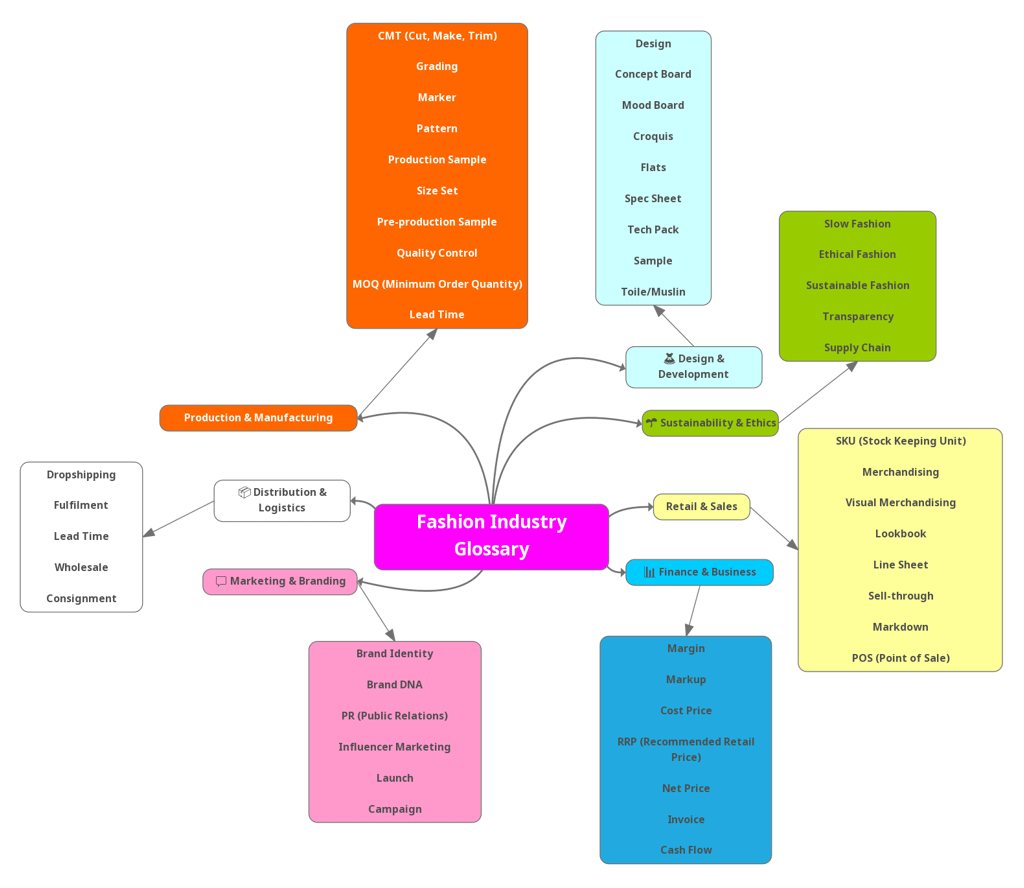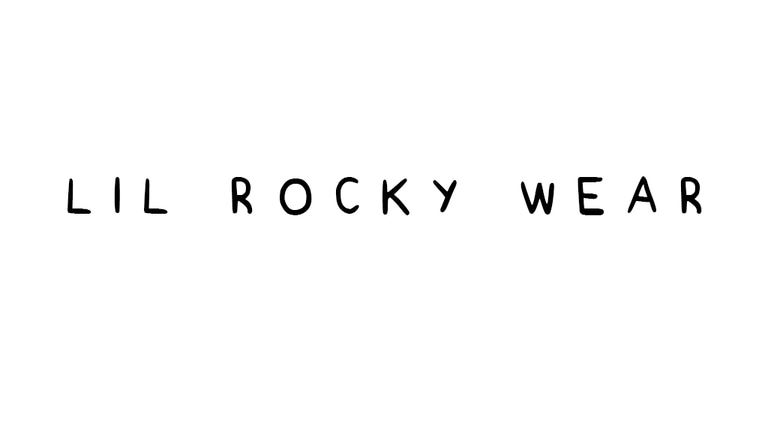Mind Map for Fashion: Enhance Your Knowledge
A Visual Mind Map of Essential Fashion Industry Terms. Whether you're a designer, business owner, or newcomer, mastering fashion terminology. Students, GCSE, A-Level Fashion, FASHION MARKETING
Introduction to Fashion Terminology
Ever felt lost in fashion lingo? Whether you're sketching your first collection or launching a brand, mastering industry terminology can boost your confidence. With countless terms, abbreviations, and phrases used daily, navigating the fashion space without a solid grasp can be daunting.
That's why we've created a comprehensive mind map to simplify essential fashion concepts—covering design, production, marketing, and sustainability.
But it’s not just about learning jargon—it’s about feeling more confident in your creative process and understanding how the industry operates behind the scenes. Imagine being able to chat with your supplier using the same terms they do or impress potential buyers with your deep knowledge of industry practices.
Fashion Terminology Categories
This visual mind map serves as a quick reference guide to help you familiarise yourself with fashion terminology. Let’s explore key categories and bring them to life with real-world examples:
🧠 Fashion Industry Glossary Mind Map
👗 Design & Development
🖊 Design
The creative process of planning and sketching clothing or accessories before they are made.
Example: UK designers like Stella McCartney and Vivienne Westwood begin their collections with sketches and vision boards before any fabric is cut. Their designs are first brought to life on paper and then translated into garments.
🖼 Concept Board
A visual presentation of themes, ideas, and inspiration used to guide a fashion collection’s development.
Example: When Gucci’s Alessandro Michele develops collections, he often uses eclectic concept boards—from vintage photography to contemporary art—to craft his bold, whimsical designs.
🎨 Mood Board
A collage of images, colours, fabrics, and textures that captures the tone and aesthetic of a collection.
Example: A mood board for a winter collection might include deep red velvet, silver sequins, and images of icy landscapes, setting the tone for a luxurious yet frosty vibe.
📏 Flats
Technical drawings of garments shown from the front and back without stylised figures, used to communicate construction details.
Example: Before a UK retailer like ASOS launches a new collection, they rely on flats—blueprints that detail seams, zippers, and design elements for production accuracy.
📜 Spec Sheet
A document listing the garment’s measurements and details, used to guide production and ensure consistency.
Example: If you're producing a fashion line, you’d send a spec sheet to the factory, detailing exact measurements, stitch types, and fabrics—just like Zara and Burberry do to ensure precision in mass production.
🧵 Production & Manufacturing
🔨 CMT (Cut, Make, Trim)
A type of garment production service where the manufacturer cuts fabric, assembles garments, and adds trims.
Example: Many UK-based independent designers use CMT factories to create high-quality bespoke pieces, similar to how large brands streamline production.
📏 Grading
The process of creating different sizes from a base pattern to fit a range of body shapes.
Example: Brands like Levi’s and Topshop ensure their jeans fit all body types by grading patterns into sizes ranging from petite to plus.
📅 Lead Time
The amount of time it takes from placing a production order to receiving finished garments.
Example: Retailers like ASOS and Boohoo carefully manage lead times to ensure timely launches—especially for seasonal collections and holiday sales.
🛍️ Retail & Sales
🔢 SKU (Stock Keeping Unit)
A unique code assigned to each product variation (e.g. size, colour) for inventory tracking.
Example: When shopping at John Lewis, every item—from socks to coats—has a unique SKU for easy stock management.
🎭 Visual Merchandising
The use of displays, layouts, and styling in retail environments to attract and engage shoppers.
Example: Luxury brands like Burberry create captivating store displays with mannequins styled in seasonal looks to enhance the shopping experience.
📸 Lookbook
A curated collection of styled photos showcasing a brand’s latest designs, often used for marketing.
Example: Brands like Mango and Zara use lookbooks to present their collections, helping buyers and customers envision styled outfits.
📦 Distribution & Logistics
🚚 Dropshipping
A fulfilment method where retailers don’t keep inventory but transfer orders to a supplier who ships products on their behalf.
Example: Many UK businesses on platforms like Etsy and Shopify use dropshipping to sell fashion items without handling stock.
📢 Wholesale
Selling goods in bulk at a lower price to retailers who sell them at a higher consumer price.
Example: Brands like Reebok and Nike wholesale their products to UK retailers like Sports Direct, who then sell them at retail prices.
💬 Marketing & Branding
🎨 Brand Identity
A brand’s colours, logo, and design elements that make it instantly recognisable.
Example: Think of Christian Louboutin’s red soles or the iconic Burberry check pattern—these elements instantly communicate brand identity.
📢 Influencer Marketing
Leveraging individuals with large social media followings to promote products.
Example: Fashion influencers like Victoria Magrath (InTheFrow) collaborate with brands like ASOS to showcase new arrivals to their audiences.
🌱 Sustainability & Ethics
🐢 Slow Fashion
A movement encouraging sustainable clothing production, opposing fast fashion.
Example: Brands like Stella McCartney and Patagonia lead the way, focusing on eco-friendly fabrics and timeless quality.
🤝 Ethical Fashion
Fashion made ensuring fair wages, safe working conditions, and responsible sourcing.
Example: UK-based brand People Tree prioritises ethical sourcing and fair wages for factory workers.
📊 Finance & Business
💰 Margin
The difference between the production cost and selling price of a product.
Example: If a coat costs £50 to produce and sells for £150, the margin is £100, or 66.7%—a key figure in setting profitable prices.
Utilising the Mind Map
This mind map is a valuable tool for anyone in fashion—from aspiring designers, students to business owners.
It serves as a refresher for seasoned professionals and an educational tool for newcomers to the industry. By adopting a common language, we improve collaboration, communication, and growth.
Understanding fashion terminology is key to navigating design and production confidently. With our visual mind map, you have a handy reference to deepen your knowledge of essential concepts in marketing, sustainability, and beyond.
📥 Download the mind map today and take your fashion expertise to the next level!


